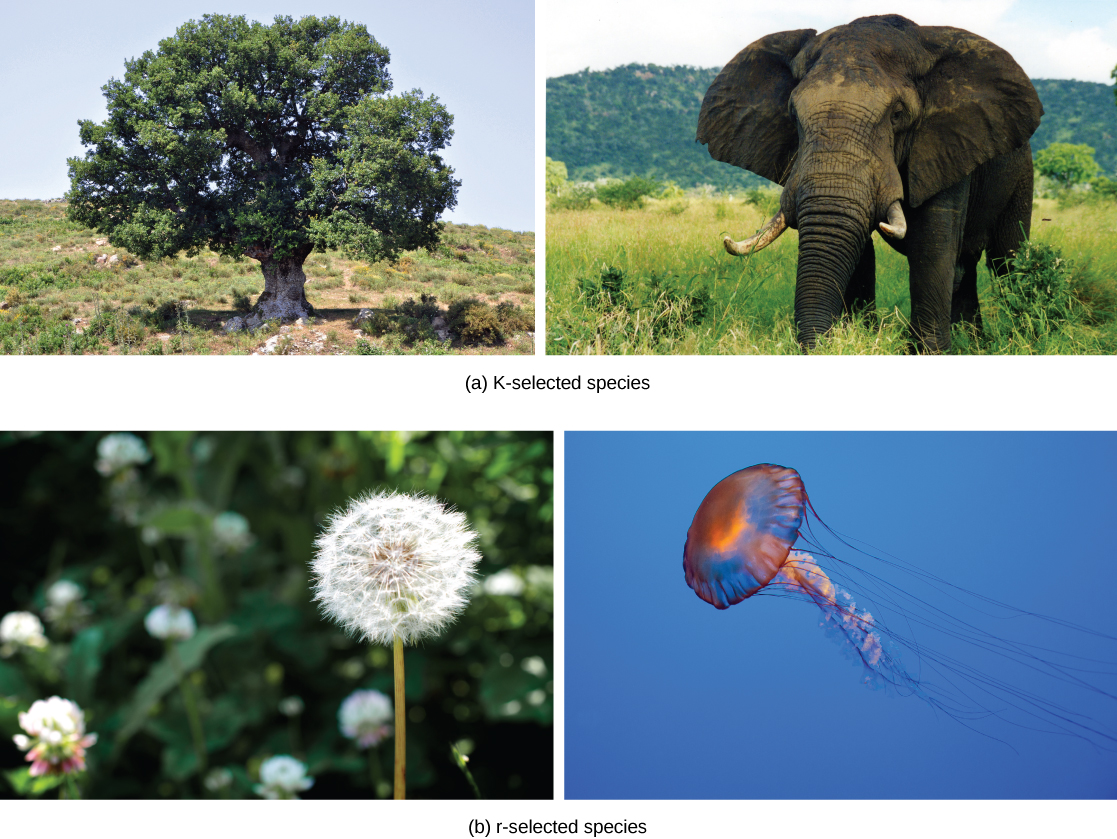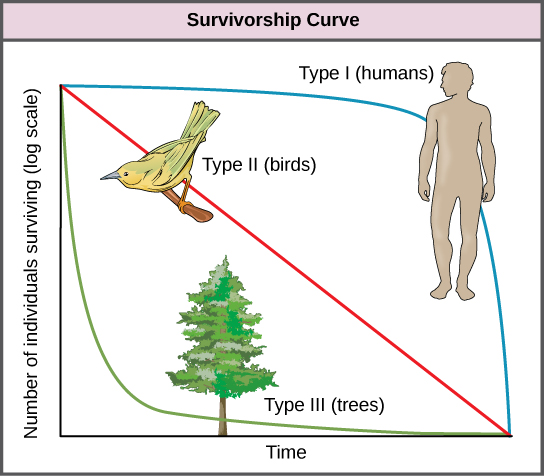Survivorship Curve Type 2 Examples
five.four: Life History
- Page ID
- 33055
Life history characteristics, are those that chronicle to the survival, mortality, and reproduction of a species. Examples include birth rates, age at first reproduction, the number of offspring, and death rates. These characteristics evolve just similar physical traits or behavior, leading to adaptations that affect population growth.
Reproductive Strategies
Population ecologists have hypothesized that suites of characteristics may evolve in species that lead to particular adaptations to their environments. These adaptations impact the kind of population growth their species experience. Population ecologists take described a continuum of life-history "strategies" with M-selected species on one terminate and r-selected species on the other (table \(\PageIndex{a}\)). Thousand-selected species are adjusted to stable, predictable environments. Populations of K-selected species tend to be close to their carrying capacity (which is represented past the alphabetic character "K" in the equation for logistic population growth). These species tend to have larger, but fewer, offspring, contribute large amounts of resources to each offspring, and have long generation times. Elephants would exist an example of a Thou-selected species (figure \(\PageIndex{a}\)). When a habitat becomes filled with a various collection of creatures competing with one some other for the necessities of life, the advantage shifts to G-strategists. One thousand-strategists have stable populations that are close to G. In that location is nothing to be gained from a loftier growth rate (r). The species will benefit most by a close accommodation to the conditions of its surroundings.
| Characteristics of Thou-selected species | Characteristics of r-selected species |
|---|---|
| Mature late | Mature early |
| Greater longevity | Lower longevity |
| Increased parental care | Decreased parental intendance |
| Strong competitors | Weak competitors (strong colonizers) |
| Fewer offspring | More offspring |
| Larger offspring | Smaller offspring |

r-selected species are adapted to unstable and unpredictable environments. They have large numbers of pocket-sized offspring. Animals that are r-selected exercise non provide a lot of resource or parental intendance to offspring, and the offspring are relatively self-sufficient at nascence. Examples of r-selected species are marine invertebrates such as jellyfish and plants such as the dandelion (effigy \(\PageIndex{a}\)).r-strategists have curt life spans and reproduce quickly, resulting in curt generation times. For example, the housefly can produce 7 generations each year (each of about 120 immature). Ragweed is well-adapted to exploiting its environment in a hurry - before competitors tin can get established. It grows quickly and produces a huge number of seeds (after releasing its pollen, the bane of many hay fever sufferers). Because ragweed'due south approach to continued survival is through rapid reproduction (a loftier value of r) it is chosen an r-strategist. Other weeds, many insects, and many rodents are also r-strategists. If fact, if we consider an organism a pest, it is probably an r-strategist.
The ii extreme strategies are at two ends of a continuum on which real species life histories will exist. In improver, life history strategies exercise not demand to evolve as suites but can evolve independently of each other; therefore, each species may have some characteristics that trend toward one farthermost or the other. Yet, the r- and M-option theory provides a foundation for a more authentic life history framework. New demographic-based models of life history development have been developed, which comprise many ecological concepts included in r- and K-choice theory besides as population age structure and mortality factors.
Life Tables
Life tables provide important data nigh the life history of an organism and the life expectancy of individuals at each age. They are modeled after actuarial tables used by the insurance manufacture for estimating human life expectancy. Life tables may include the probability of each age group dying before their next altogether, the pct of surviving individuals dying at a detail age interval (their mortality rate, and their life expectancy at each interval). An example of a life tabular array is shown in Tabular array \(\PageIndex{b}\) from a written report of Dall mountain sheep, a species native to northwestern N America. Notice that the population is divided into age intervals (column A).
As tin can exist seen from the mortality rate information (column D), a high death rate occurred when the sheep were betwixt half-dozen months and a year old, and then increased fifty-fifty more from 8 to 12 years old, after which there were few survivors. The information signal that if a sheep in this population were to survive to age one, it could be expected to alive another seven.vii years on average, as shown past the life-expectancy numbers in cavalcade Eastward. Life tables often include more data than shown in Table \(\PageIndex{b}\), such every bit fecundity (reproduction) rates for each age group.
| Age interval (years) | Number dying in age interval out of 1000 built-in | Number surviving at beginning of age interval out of m born | Mortality rate per 1000 alive at beginning of age interval | Life expectancy or mean lifetime remaining to those attaining age interval |
|---|---|---|---|---|
| 0–0.5 | 54 | 1000 | 54.0 | 7.06 |
| 0.5–1 | 145 | 946 | 153.3 | — |
| 1–2 | 12 | 801 | 15.0 | 7.7 |
| 2–three | thirteen | 789 | 16.5 | 6.8 |
| 3–4 | 12 | 776 | xv.5 | 5.9 |
| 4–five | 30 | 764 | 39.3 | 5.0 |
| five–6 | 46 | 734 | 62.vii | 4.two |
| 6–7 | 48 | 688 | 69.viii | three.iv |
| 7–viii | 69 | 640 | 107.8 | 2.6 |
| 8–9 | 132 | 571 | 231.2 | 1.9 |
| 9–10 | 187 | 439 | 426.0 | one.iii |
| x–11 | 156 | 252 | 619.0 | 0.9 |
| xi–12 | xc | 96 | 937.5 | 0.half-dozen |
| 12–13 | 3 | six | 500.0 | 1.2 |
| thirteen–14 | 3 | 3 | yard | 0.vii |
Survivorship Curves
Another tool used past population ecologists is a survivorship curve, which is a graph of the number of individuals surviving at each age interval versus time. These curves allow united states of america to compare the life histories of dissimilar populations (figure \(\PageIndex{c}\)). At that place are 3 types of survivorship curves. In a blazon I survivorship curve, mortality is low in the early on and centre years and occurs mostly in older individuals. Organisms exhibiting a type I survivorship typically produce few offspring and provide practiced intendance to the offspring increasing the likelihood of their survival. Humans and well-nigh mammals showroom a type I survivorship bend. In type 2 survivorship curves, bloodshed is relatively abiding throughout the entire life span, and mortality is equally probable to occur at any point in the life span. Many bird populations provide examples of an intermediate or type II survivorship bend. In type III survivorship curves, early on ages experience the highest bloodshed with much lower mortality rates for organisms that make it to advanced years. Type III organisms typically produce large numbers of offspring, but provide very fiddling or no care for them. Trees and marine invertebrates exhibit a type 3 survivorship curve because very few of these organisms survive their younger years, but those that practise make it to an onetime historic period are more likely to survive for a relatively long period of fourth dimension.

While is no exact association between reproductive strategies (K- orr-selected) and survivorship curves (Type I, 2, or III), Thousand-selected species are more probable to have a Blazon Iii survivorship curve.r-selected species tend to have a Type I survivorship curve.
Survivorship Curve Type 2 Examples,
Source: https://bio.libretexts.org/Bookshelves/Ecology/Environmental_Science_%28Ha_and_Schleiger%29/02:_Ecology/2.02:_Populations/2.2.04:_Life_History
Posted by: crousesligized56.blogspot.com



0 Response to "Survivorship Curve Type 2 Examples"
Post a Comment